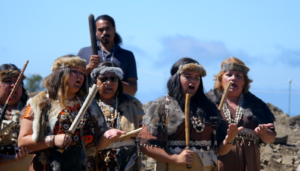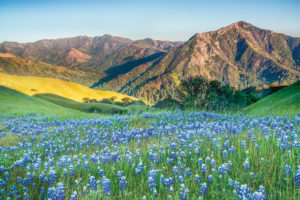According to comparative religion scholar and mountain climber Edwin Bernbaum, a lot of important things in the Bible happen on mountains: Moses’ receiving the Ten Commandments, Noah’s landing on Mt. Ararat after the flood, Abraham offering up Isaac on Mt. Moriah, to name a few. A former program director and currently senior fellow at The Mountain Institute, a Washington, DC-based nonprofit, Ed has spent his career climbing some of the world’s highest peaks and bringing back a compelling message: Nature can be protected by connecting more people with mountains and the environment through the lens of their own cultural and spiritual experiences.
Bernbaum is the author of the books Sacred Mountains of the World (UC Press) and The Way to Shambhala and serves as the co-chair of the working group on the Cultural and Spiritual Values of Protected Areas for the International Union for Conservation of Nature (IUCN).

Where did you grow up, and what brought you to the Bay Area?
I grew up in Washington, DC, and various countries in Latin America – Nicaragua, Ecuador, Venezuela, and Argentina. I came to Berkeley to write a book on Tibetan myths of hidden valleys and wound up getting a Ph.D. in Asian Studies at UC Berkeley after doing graduate work at Harvard in social psychology and anthropology.
Was there one peak in particular that inspired your work of preserving mountain environments?
The mountain that’s had the most influence on me is Annapurna in the Himalayas of Nepal. When I was a teenager my sister checked the book Annapurna out of the library. I read it, and was impressed by how the author had a profound spiritual experience as he reached the summit. A year or so later, in 1960, my family moved to Quito, Ecuador, and I started climbing in the Andes with an Ecuadorean mountaineering club; I thought it would be interesting to go up to snow on the equator. With my Ecuadorean friends I climbed Cotopaxi, the highest active volcano in the world and made the first ever ascent of the South Antizana.
Later, in 1968 I went with the Peace Corps to Nepal, and went on expedition trying to climb one of the high peaks in the Annapurna Range. But during the attempt to reach the summit, two of us were caught in huge ice avalanche and I was swept down 1,000 feet and buried beneath the snow.

Were you frightened away from mountains after that experience?
No, the experience was a major turning point in my life. To my surprise, rather than giving me nightmares, the avalanche became a positive source of insight into what I was looking for in climbing and in life. Shortly afterwards, I climbed a peak near Everest and ended up befriending the head lama or abbot (spiritual leader) of Tengboche Monastery near the foot of Everest and trekked with him back to Kathmandu, the capital of Nepal. That’s when I began to get interested in what mountains mean to different religions and cultures.
Tell us about the program you worked on with The Mountain Institute and the US National Park Service starting in 1998.
National parks enshrine values that are important to American culture – ideas of freedom and the concept of wilderness, for example. But most visitors to parks have traditionally been middle-class white Americans and foreign tourists. So we wanted to broaden that audience and connect more people from diverse cultural and ethnic groups.
We worked with the Park Service developing interpretive materials to help connect a broad range of visitors with nature, enrich their experiences, and give them deep-seated, sustainable reasons for conserving the environment. We wanted to expand the parks’ relevance based on the cultural and spiritual meanings of their natural features, notably in Yosemite, Hawai’i’s Volcanoes, and the Great Smoky Mountains. Yosemite, for instance, has special significance for a lot of people, ranging from Native Americans in the Sierra Nevada to the general public, especially for residents of the Bay Area. The inspirational significance of Yosemite in the writings of John Muir played a major role in the development of the National Park system and the modern-day environmental movement. Efforts to conserve the environment need to involve the diverse peoples and traditions that are inspired to care for nature.
What is the goal of the workshop you will be leading at the IUCN’s upcoming World Parks Congress?
We want to bring together the managers of parks and other protected areas, environmental leaders representing the general public, and representatives from indigenous cultures and mainstream religions to develop practical measures to incorporate an understanding of the cultural and spiritual significance of nature into the management and governance of protected areas.
What about the spiritual significance of our local mountains?
Bay Area mountains are places of spiritual renewal for many people, starting with our local indigenous peoples like the Ohlone. Perhaps the most important mountain in the area from this point of view is Mount Diablo. There is a flood story that tells how a flood inundated the world, leaving only the summit of the mountain above the water. Coyote, Hummingbird and Eagle got together there to recreate the human race and repopulate the world after the waters receded. It’s somewhat similar to the story of Mount Ararat and Noah’s ark in the Bible.
What’s your favorite mountain in the Bay Area?
My favorite is Mount Tamalpais; from the base to the summit, it has almost every type of ecosystem you can find in the Bay Area. I love to walk along the high trails above Stinson Beach contouring the mountainside with spacious views of the land and the ocean. Gary Snyder and other Beat poets set up a Buddhist route that goes around the mountain. The Buddhist practice is to circumbulate a mountain, not just climb it. And walking through an old-growth forest like Muir Woods produces the kind of experience that inspires people to protect the trees and the environment.
Learn more . . .
>> IUCN World Parks Congress 2014
>> Ed’s Peak Paradigms website focuses on his work as a leadership coach.





